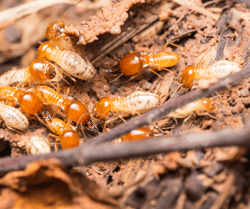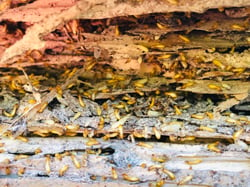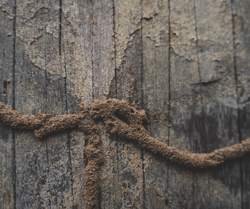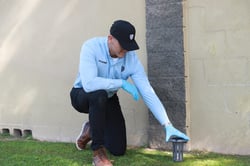Termites. The word alone is enough to strike fear in homeowners – and for good reason! Termites are among the most destructive household pests. With voracious appetites and the ability to reproduce seemingly overnight, termites can bring even the sturdiest of homes to their knees. The worst part? Termites are hard to catch in their early stages and can cause significant damage in a relatively short time span. So how can homeowners protect themselves and identify the earliest indicators of a termite infestation?

What species of termite is in my home?
Unfortunately, spotting the signs of an early-stage termite infestation can be surprisingly difficult, especially if you’re not sure which termite species you’re looking out for. For the sake of this article, we will be focusing on the signs of a Subterranean termite infestation for a simple reason: Subterranean termites are, by and large, the most frequently encountered termite in the United States and happen to cause the most significant home damage. However, we believe it is important to be familiar with all common species of termites as a homeowner.
Subterranean Termites
Beginning with the most abundant of all termite species, Subterranean termites are commonplace in every U.S. state with the exception of Alaska. When most homeowners think of termites, they’re probably picturing the Subterranean termite. As their name suggests, these termites live primarily underground in large colonies and feast on any type of wood available to them. They also construct elaborate mud tunnels on the surface, thriving when in contact with moist soil or other water sources.
Drywood Termites
Unlike Subterranean Termites, Drywood Termites don't burrow deep into the moist soil for protection. In fact, they like much less moisture in their environment and food, preferring wood with a moisture content of 12% or less. Due to this, Drywood termites are common in areas with hot and dry climates like the Pacific coast, Central Valley, and the desert of Southern California. These termites enjoy hard and soft woods and live directly inside the wood they consume.
Dampwood Termites
Aptly named, Dampwood Termites flock to wood with high moisture content and live within the wood itself. Because homes are typically constructed with dry wood, Dampwood termites are not very common in most homes. That said, outdoor wooden structures that are exposed to regular moisture, such as fences or sheds are prime locations for Dampwood Termites to settle down! Due to their preference for a moist environment, Dampwood termites are most prevalent in the wetter Western or Southern states.
Formosan Termites
Considered a highly invasive species, Formosan Termites originated in China but have since invaded the southern United States. They are larger than most termite species and extremely aggressive in their destruction; a colony of Formosan Termites can consume more than an ounce of wood a day! Because they prefer a milder climate, Formosan Termites have become relatively common in the following U.S. states: Florida, Alabama, Georgia, Louisiana, Mississippi, South Carolina, North Carolina, Tennessee, Virginia, Texas, Arizona, California and Hawaii.
.png?width=250&height=210&name=Termite%20(1).png) Subterranean Termite
Subterranean Termite
What damage do Subterranean termites cause?
Depending on the size of the Subterranean termite colony, damage can be considerable. Because termites feed primarily on wood, they have the capability of compromising the structural integrity of your home. This means they can jeopardize your home’s integrity, weakening the architectural stability and even rendering structures uninhabitable. A home’s framing can be obliterated by a large colony and walls, ceilings, floors, and subfloors can collapse from catastrophic termite damage. The damage termites can cause should not be underestimated.
 Wood damaged by Subterranean termites
Wood damaged by Subterranean termites
What are the signs of Subterranean termite damage?
Unfortunately, some termite damage does not become apparent until a full-blown infestation occurs. This is especially true for internal damage, as termites typically work from the outside inward. Internal damage nearly always points to an infestation left unchecked, and it’s highly probable that there is considerable exterior damage, as well. Luckily, there are some signs of termite damage to look out for to prevent further damage.
-
Buckling wood
-
Swollen floors or subfloors
-
Bulging ceilings
-
Damage on walls and ceilings that looks like water damage
-
Discolored or drooping drywall
-
Visible mazes within walls or furniture
-
Peeling paint
-
Mud tubes located near the foundation of the home
-
Cracked wood furniture or other wooden items
-
Small holes in drywall
-
A mildew or mold-like scent
-
Sudden or overt squeaking in floorboards
-
Wing piles left after swarms
If you spot signs of a potential termite infestation in your home, contact a trusted pest professional immediately. Catching an infestation early and before too much damage has been caused is the best way to protect the integrity of your home and avoid shelling out several thousand dollars in repair costs.
 Subterranean termite mud tubes
Subterranean termite mud tubes
How do I prevent Subterranean termite damage?
The only way to prevent Subterranean termite damage is to prevent termites from attacking your home altogether. While certainly easier said than done, there are a few ways that you can help make your home a less easily accessed or hospitable place for termites to hang out. Some prevention tactics include:
- Remove any unnecessary lumber, mulch, wood, or other cellulose-based debris from near the foundation of your home.
- Stack firewood away from the home and ensure the wood is raised off the ground.
- Be mindful of landscaping around the foundation of your home. Wood mulch against your home’s foundation may draw termites near.
- Consider using pine needles or pea gravel in your landscaping.
- Regularly cut and rake any grass near your home.
- Reduce moisture around your home’s foundation by ensuring water from gutters or other drainage is directed away from the home.
- Ensure sprinkler heads are pointed away from the home.
- Utilize vapor blocks to reduce moisture and use dehumidifiers where needed.
- Keep dead trees, rooting wood, and tree stumps away from the home.
- Seal cracks around your home foundation and utilities that may lead to water entry or buildup.
- Turn off outdoor lights at night as they can attract flying termites and swarms.
- Check your roof for signs of water damage, mold, or rot. This is especially important for homes with flat areas of their roof where standing water can accrue.
- Get regular termite inspections from a trusted pest professional.
- Sign up for termite monitoring services from a trusted pest professional.
 EcoShield technician installing a termite monitor.
EcoShield technician installing a termite monitor.
What do I do if I have Subterranean termites in my home?
If you suspect you have Subterranean termites in your home, we recommend you call a trusted pest professional like EcoShield immediately. Time is of the essence when dealing with termites, and delays in receiving treatment can result in more damage caused and more money required. With the Shield Termite Program, EcoShield offers year-round protection against termites and catches any potential termite activity before it becomes a headache.
A thorough inspection of your home will allow EcoShield pest technicians to identify problem areas and target them for treatment. EcoShield’s proven termite removal strategy ensures the entire colony is treated through the use of dependable products and with the informed knowledge of a termite’s habits, life cycle, and biology. Termite monitors will be installed every 15 feet to detect termite activity before it becomes catastrophic to your home and wallet.
If you’re experiencing a problem with termites in your home or would like to prevent termite damage in the future, call EcoShield today for a free, no-obligation quote.